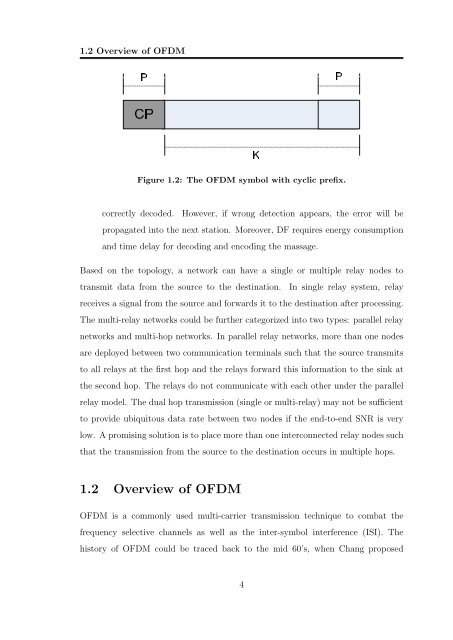Resource Allocation in OFDM Based Wireless Relay Networks ...
Resource Allocation in OFDM Based Wireless Relay Networks ...
Resource Allocation in OFDM Based Wireless Relay Networks ...
Create successful ePaper yourself
Turn your PDF publications into a flip-book with our unique Google optimized e-Paper software.
1.2 Overview of <strong>OFDM</strong><br />
Figure 1.2: The <strong>OFDM</strong> symbol with cyclic prefix.<br />
correctly decoded. However, if wrong detection appears, the error will be<br />
propagated <strong>in</strong>to the next station. Moreover, DF requires energy consumption<br />
and time delay for decod<strong>in</strong>g and encod<strong>in</strong>g the massage.<br />
<strong>Based</strong> on the topology, a network can have a s<strong>in</strong>gle or multiple relay nodes to<br />
transmit data from the source to the dest<strong>in</strong>ation. In s<strong>in</strong>gle relay system, relay<br />
receives a signal from the source and forwards it to the dest<strong>in</strong>ation after process<strong>in</strong>g.<br />
The multi-relay networks could be further categorized <strong>in</strong>to two types: parallel relay<br />
networks and multi-hop networks. In parallel relay networks, more than one nodes<br />
are deployed between two communication term<strong>in</strong>als such that the source transmits<br />
to all relays at the first hop and the relays forward this <strong>in</strong>formation to the s<strong>in</strong>k at<br />
the second hop. The relays do not communicate with each other under the parallel<br />
relay model. The dual hop transmission (s<strong>in</strong>gle or multi-relay) may not be sufficient<br />
to provide ubiquitous data rate between two nodes if the end-to-end SNR is very<br />
low. A promis<strong>in</strong>g solution is to place more than one <strong>in</strong>terconnected relay nodes such<br />
that the transmission from the source to the dest<strong>in</strong>ation occurs <strong>in</strong> multiple hops.<br />
1.2 Overview of <strong>OFDM</strong><br />
<strong>OFDM</strong> is a commonly used multi-carrier transmission technique to combat the<br />
frequency selective channels as well as the <strong>in</strong>ter-symbol <strong>in</strong>terference (ISI). The<br />
history of <strong>OFDM</strong> could be traced back to the mid 60’s, when Chang proposed<br />
4

















